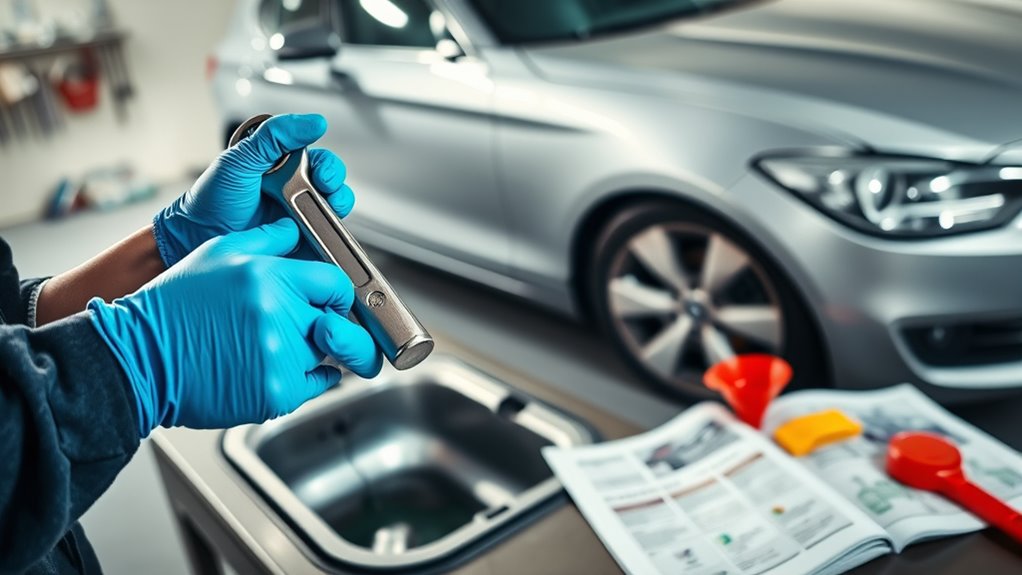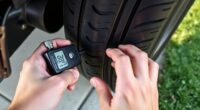You can easily handle basic car maintenance tasks at home, saving money and boosting your vehicle’s performance. Tasks like rotating tires, changing the oil, checking tire pressure, replacing air filters, inspecting brakes, and topping up fluids are simple with the right tools and some guidance. Doing these yourself helps prevent breakdowns and extends your car’s lifespan. Keep exploring, and you’ll discover step-by-step tips to make each task even easier.
Key Takeaways
- Learn to perform tire rotations to prolong tire life and improve vehicle handling.
- Change your vehicle’s oil regularly to maintain engine performance and prevent damage.
- Check and replace air filters to ensure optimal airflow and fuel efficiency.
- Inspect and replace windshield wipers for clear visibility and safety.
- Maintain fluid levels (coolant, brake fluid, transmission fluid) to avoid costly repairs and ensure smooth operation.

Taking care of your car yourself can save money and give you a better understanding of how your vehicle works. One of the simplest yet most effective maintenance tasks you can do is performing a tire rotation. Regularly rotating your tires ensures even wear, which extends their lifespan and maintains ideal traction. To do this, you’ll need a jack, a lug wrench, and possibly a torque wrench. Start by parking your car on a flat surface, engaging the parking brake, and loosening the lug nuts slightly before lifting the vehicle. Once elevated, remove the wheels and switch their positions according to your vehicle’s recommended rotation pattern—usually front to back and vice versa. After repositioning the tires, tighten the lug nuts securely, lower the car, and finish tightening them to the proper torque specifications. This process takes roughly 30 minutes and can be done every 5,000 to 7,500 miles, depending on your driving conditions.
Another fundamental task you can handle is an oil change. Fresh oil keeps your engine lubricated, cool, and running smoothly, preventing costly repairs down the line. To start, gather the right type of oil for your vehicle, a new oil filter, a wrench, a drain pan, and safety gloves. Warm up your engine for a few minutes to help the oil drain more thoroughly, then turn off the engine and carefully lift the front of your car using a jack and jack stands if necessary. Place the drain pan under the oil pan drain plug, loosen it with a wrench, and let the oil drain completely. Once drained, replace the drain plug securely, remove the old oil filter, and install a new one, making sure it’s tightened properly. Fill the engine with the recommended amount of fresh oil, check the oil level with the dipstick, and add more if needed. Reset your oil change indicator if your vehicle has one, and dispose of the used oil responsibly at a recycling center.
Performing these basic maintenance tasks at home not only saves you money on labor costs but also keeps you connected to your vehicle’s health. Tire rotation and oil changes are routine procedures that prevent breakdowns and promote longevity. By doing them yourself, you gain confidence in handling your car and develop a better understanding of its operation. Just remember to consult your owner’s manual for specific instructions and torque specifications, and always prioritize safety when working underneath your vehicle. Being aware of vehicle maintenance concepts can help you make informed decisions and ensure your vehicle remains reliable. With a little time and the right tools, you can keep your car running smoothly without frequent trips to the shop.
Frequently Asked Questions
How Often Should I Change My Car’S Oil Myself?
You might wonder how often you should change your car’s oil yourself. Typically, the oil change frequency depends on your vehicle and driving habits, but many recommend every 3,000 to 5,000 miles. For DIY oil maintenance, check your owner’s manual for specifics. Doing it yourself saves money and time, and if you stay consistent, you’ll keep your engine running smoothly without needing professional help every time.
Can I Replace Brake Pads Without Professional Help?
Thinking of replacing brake pads yourself might seem intimidating, but with careful brake pad inspection and understanding brake pad replacement steps, you can take control. You need to torque the caliper bolts correctly and make sure the rotor surface is smooth. If you follow detailed guides and have the right tools, you can safely do it. However, if you’re unsure, it’s wise to consult a professional to keep your brakes in top shape.
What Tools Are Essential for DIY Car Maintenance?
To handle DIY car maintenance, you need essential tools like basic hand tools—wrenches, screwdrivers, pliers—and safety gear such as gloves and eye protection. These tools help you perform tasks safely and efficiently. Having a reliable jack and jack stands is also vital for lifting your vehicle. Always prioritize safety, follow instructions carefully, and make sure your tools are in good condition to avoid accidents or damage.
Is It Safe to Work Under My Car Without a Lift?
You might find yourself wondering if it’s okay to work under your car without a lift. While a sturdy car jack can be reliable, it requires careful attention to car jack safety to prevent accidents. Always use jack stands on a flat surface for undercarriage inspection, never rely solely on a jack. If you’re unsure, seeking professional help guarantees your safety and keeps your DIY efforts worry-free.
How Do I Diagnose Engine Problems at Home?
To diagnose engine problems at home, start by listening for unusual engine noise, which can hint at specific issues. Use diagnostic tools like an OBD-II scanner to read trouble codes from your car’s computer, helping identify problems quickly. Check for warning lights on your dashboard and inspect for leaks or loose belts. Taking these steps allows you to pinpoint issues early and decide whether professional help is needed.
Conclusion
Doing your own car maintenance saves you money and boosts your confidence—did you know that regular DIY checks can extend your vehicle’s lifespan by up to 20%? With just a few simple tasks, you’re not only saving time and cash but also gaining a better understanding of your car’s health. So go ahead, roll up your sleeves—you’re capable of keeping your car in top shape right from your driveway!









